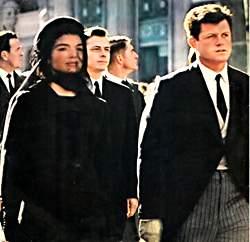Culture Polices the Expression of Grief
 We all grieve. However, while grief is a universal phenomenon, its expression and duration varies cross-culturally and individually. As a cultural anthropologist and grief and loss coach I am familiar with diverse cultural expressions of grief and mourning. For example, many Americans continue to model their expression of grief on Jacquelyn Kennedy’s stoicism portrayed during the first funeral ever broadcast on television–the November 1963 funeral of JFK. Because of mass media Jacquelyn’s dry-eyed, silent demeanor became a dominant cultural model for an appropriate emotional experience to grief and loss, one that is often emulated today in the United States. However in other countries, such as Ireland, women may wail and lament loudly, or “keen” after a death but cease public mourning when the “wake” or several day celebration of life begins.
We all grieve. However, while grief is a universal phenomenon, its expression and duration varies cross-culturally and individually. As a cultural anthropologist and grief and loss coach I am familiar with diverse cultural expressions of grief and mourning. For example, many Americans continue to model their expression of grief on Jacquelyn Kennedy’s stoicism portrayed during the first funeral ever broadcast on television–the November 1963 funeral of JFK. Because of mass media Jacquelyn’s dry-eyed, silent demeanor became a dominant cultural model for an appropriate emotional experience to grief and loss, one that is often emulated today in the United States. However in other countries, such as Ireland, women may wail and lament loudly, or “keen” after a death but cease public mourning when the “wake” or several day celebration of life begins.
Culture Polices the Expression of Grief
Culture—which includes religious or spiritual beliefs–polices the expression of grief (Walter 1999). Culture controls and informs the bereaved how to think, feel, and behave. Across cultures “there is a wide spectrum in terms of which emotions are acceptable and in how emotions should be expressed” (Klass and Chow 2011: 344). Furthermore, “appropriate” emotions are often tied to gender roles–in our North American culture women are typically expected to cry whereas men are expected to be less emotional.
Culture Polices the Bonds the Living Have with the Dead
Culture also polices the bonds that the living have with the dead. In some cultures ongoing bonds with the dead are a normal part of everyday life. For example the Japanese have ancestor rituals in which the dead are believed to pass easily from afterlife to physical life. In contemporary Northern American and Western European culture, continuing bonds with the dead are typically restricted to the private sphere. Nonetheless, reports of hearing, feeling, and seeing the deceased after the death or in dreams are widespread and often described as soothing and reassuring (see my blog on “Cleaning out Your Deceased Loved One’s Closet”).
To Remember
1) The expression and duration of grief varies culturally and individually.
2) Continuing bonds with the dead–from reminiscing with others about the deceased to dreaming about or intuiting ones departed loved one–are a normal part of everyday life around the world.
3) A grief and loss coach will accept your unique expression of grief without judgment, preconceived time lines or arbitrary linear stages of grieving, while helping you to move from pain to purpose.
Works Cited
Klass, Dennis., and Amy Chan
2011 Culture and Ethnicity in Experiencing, Policing, and Handling Grief. In Grief and Bereavement in Contemporary Society: Bridging Research and Practice. Eds., Robert Neimeyer, Darcy L. Harris, Howard R. Winokuer, and Gordon F. Thornton.
Walter, Tony
1999 On Bereavement: The Culture of Grief. Buckingham: Open University
Press.
Article Images




Comments